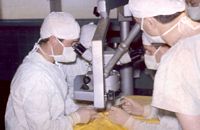


The development of microvascular surgery in Australia
Introduction
Participants
Beginnings
Developing links with academia and hospital medicine
A bevy of supporters
An ever-widening circle of contributors
Building research capacity
Nurturing relationships
Raising funds for research and development
The microsurgeon and the law
Winning community and corporate support
Leadership
The Institute and its style
Endnotes
Index
Search
Help
Contact us

Now, of course, the fundamental reason for the Institute's existence is the patients, a number of whom are pictured here. The lady on the left had her face torn away and had to have major reconstruction to reattach it. The boy on the right had a new thumb provided for his hand using one of his big toes. Underpinning the surgery required was research conducted in laboratories and operating theatres which we値l be hearing about today.

Microsurgery on actual patients was preceded by extensive research. Used with the permission of the Bernard O達rien Institute of Microsurgery.
Now, none of this would have happened without some of the personalities that featured large in the history of the institute. I've chosen images of a few key players, but of course there were many more. And here is an image of the leadership team which retained a large element of consistency over the years and which has benefited the Institute.
Then there are the fund-raisers who have played an essential role in the history and pre-history of the Institute, as successive Annual Reports indicate. They conducted many successful events, such as the Concert of the Year.
Other well-publicised events in the history of the Institute were the visits of State and Federal politicians and celebrities such as Archbishops, Nobel laureates and community leaders. These visits provided the Institute with legitimacy and a following among influential people in the community.
Achieving adequate accommodation and facilities for staff has always been a major concern because the laboratories, operating theatres and so on are where the science is conducted.
When we gathered briefly before today's meeting started, I heard quite a lot of discussion about Bernard O達rien. It seems fitting that we begin with some recollections of him and his motivation to get involved in microsurgery. Perhaps we could start with Sir Laurence Muir who regularly received phone-calls from Mr O達rien on Sunday mornings after Mass, as I understand it.[6]
 |
Witness to the History of Australian Medicine |  |
© The University of Melbourne 2005-16
Published by eScholarship Research Centre, using the Web Academic Resource Publisher
http://witness.esrc.unimelb.edu.au/040.html